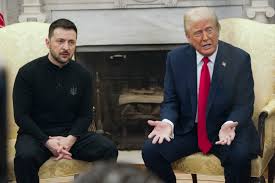US to send ‘more weapons’ to Ukraine, says Trump, days after ordering pause in deliveries

In a dramatic policy shift, former President Donald Trump announced the United States would resume arms deliveries to Ukraine, just days after halting the shipments over concerns about depleting domestic stockpiles. The unexpected reversal comes as Russian missile and drone attacks intensify across Ukrainian cities, inflicting heavy civilian casualties and pushing Kyiv’s defense systems to the brink.
From Pause to Push: The Sudden Policy Turnaround
Trump’s decision to pause military deliveries, revealed in late June, had raised alarm among both Ukrainian officials and NATO allies. The temporary freeze involved vital weapons such as Patriot missiles, NASAMS interceptors, Stinger anti-aircraft systems, and guided multiple launch rocket systems (GMLRS)—all critical for Ukraine’s air defense against relentless Russian strikes.
At the time, Trump defended the pause as a strategic necessity. “America cannot weaken its own arsenal,” he had said during a press briefing. “We’re reviewing our defense stockpile to make sure we’re ready for any threat to our homeland.”
However, just four days later, Trump reversed course, stating that Ukraine’s immediate need for advanced weapons outweighed the temporary concerns about American reserves. “We’re sending more weapons. They need them now,” he told reporters on Monday, July 8.
Why the U-Turn? Civilian Deaths and Strategic Pressure
According to White House insiders, two major developments prompted the sudden change of heart:
- Deadly Russian airstrikes: Over the weekend, a series of Russian missile attacks on Kyiv, Dnipro, and Kharkiv killed at least 11 civilians, injured over 80, and destroyed vital infrastructure, including a children’s hospital in Kyiv. Graphic images of rescue efforts went viral, fueling global outrage.
- Diplomatic outreach: Ukrainian President Volodymyr Zelenskyy reportedly held a phone call with Trump on Friday, urging the U.S. to continue support. The two leaders discussed Ukraine’s critical shortage of air-defense weapons and the rising threat to civilian populations.
Speaking after the call, Zelenskyy said, “We welcome President Trump’s renewed commitment to our defense. We cannot afford delays when our people are dying.”
What Weapons Are Being Sent Now?
According to Pentagon sources, the resumed shipments will include:
- Patriot interceptor missiles
- Stinger anti-aircraft missiles
- AIM-120 missiles for NASAMS and potential future F-16 deployment
- AT-4 anti-tank systems
- Roughly 250 GMLRS rockets, which can target Russian supply lines and command posts
Additionally, discussions are underway to transfer a third Patriot battery from U.S. stockpiles to Ukraine, a move that would significantly enhance Kyiv’s ability to shield urban centers from Russian aerial attacks.
Mixed Reactions from Washington
The sudden shift in policy has drawn mixed reactions across Washington.
Democrats and centrist Republicans welcomed the reversal, emphasizing the importance of U.S. leadership in defending democratic nations. Senator Lindsey Graham said, “This move sends a clear signal to Moscow: America stands with Ukraine, no matter what.”
However, Trump’s isolationist base is critical of the decision. Some right-wing figures argue that the U.S. should not prioritize foreign conflicts while struggling with domestic challenges like inflation and immigration.
Senator J.D. Vance called the flip-flop “politically reckless” and accused Trump of “bending to foreign pressure.”
A Test of NATO Solidarity
Trump’s reversal also comes just ahead of the NATO summit in Washington, where member states are expected to announce further coordinated support for Ukraine. Germany has already pledged to send another Patriot system, while the Netherlands and Norway are ramping up supplies of drones and surveillance equipment.
NATO Secretary General Jens Stoltenberg praised the U.S. decision, saying, “This is a crucial time. We must ensure Ukraine has the means to defend its people and its sovereignty.”
Trump’s Political Calculations
While the humanitarian situation may have pushed the decision, political analysts also see electoral motives behind Trump’s actions.
With the 2024 presidential race heating up, Trump’s critics accused him of sending mixed signals on Ukraine, potentially undermining U.S. credibility abroad. The decision to resume shipments allows him to reaffirm U.S. strength while maintaining the rhetoric of “America First.”
“Trump wants to appear strong but practical,” says political analyst Carla Brooks. “He’s balancing the base’s demand for restraint with the broader electorate’s support for Ukraine.”
On the Ground in Ukraine: Relief and Caution
Ukrainian officials and citizens have greeted the announcement with cautious optimism. “This gives us hope,” said Oksana, a paramedic in Dnipro. “Every missile we can shoot down saves lives.”
However, military analysts warn that delivery speed and logistics remain critical. “Weapons promised are not weapons deployed,” notes former Ukrainian defense official Andriy Zagorodnyuk. “We need immediate air defense, not diplomatic timelines.”
Conclusion: Support with Strings Attached?
While the Biden administration had largely offered Ukraine unconditional support, Trump’s more transactional approach may lead to future conditions tied to U.S. aid. Reports suggest the White House is considering mechanisms to audit and track weapons more closely, a move likely aimed at both domestic critics and international partners.
The coming weeks will test whether this policy change was merely reactive or the beginning of a more consistent U.S. strategy toward Ukraine under Trump’s leadership.






